belt VAUXHALL COMBO D 2018 User Guide
[x] Cancel search | Manufacturer: VAUXHALL, Model Year: 2018, Model line: COMBO D, Model: VAUXHALL COMBO D 2018Pages: 203, PDF Size: 4.76 MB
Page 48 of 203

46Seats, restraints
Loose or bulky clothing prevents the
belt from fitting snugly. Do not place
objects such as handbags or mobile
phones between the belt and your body.
9 Warning
The belt must not rest against hard
or fragile objects in the pockets of
your clothing.
Height adjustment
1. Pull belt out slightly.
2. Shift the height adjuster upwards or press button down todisengage and push the height
adjuster downwards.
Adjust the height so that the belt lies
across the shoulder. It must not lie
across the throat or upper arm.
9 Warning
Do not adjust while driving.
Page 49 of 203
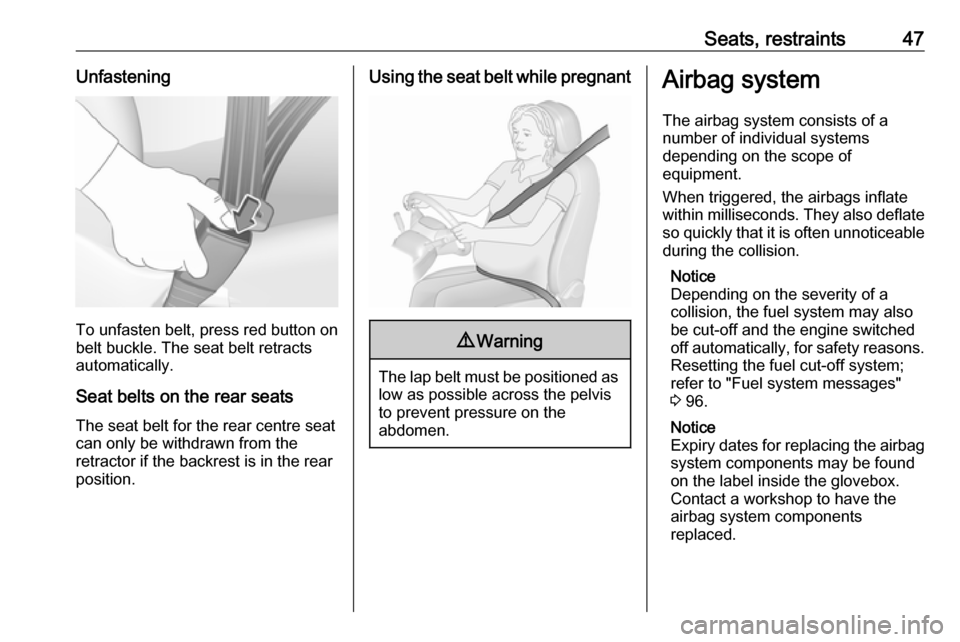
Seats, restraints47Unfastening
To unfasten belt, press red button on
belt buckle. The seat belt retracts automatically.
Seat belts on the rear seats The seat belt for the rear centre seat
can only be withdrawn from the
retractor if the backrest is in the rear
position.
Using the seat belt while pregnant9 Warning
The lap belt must be positioned as
low as possible across the pelvis
to prevent pressure on the
abdomen.
Airbag system
The airbag system consists of a
number of individual systems
depending on the scope of
equipment.
When triggered, the airbags inflate
within milliseconds. They also deflate
so quickly that it is often unnoticeable
during the collision.
Notice
Depending on the severity of a
collision, the fuel system may also be cut-off and the engine switched
off automatically, for safety reasons. Resetting the fuel cut-off system;
refer to "Fuel system messages"
3 96.
Notice
Expiry dates for replacing the airbag system components may be found
on the label inside the glovebox. Contact a workshop to have the
airbag system components
replaced.
Page 50 of 203
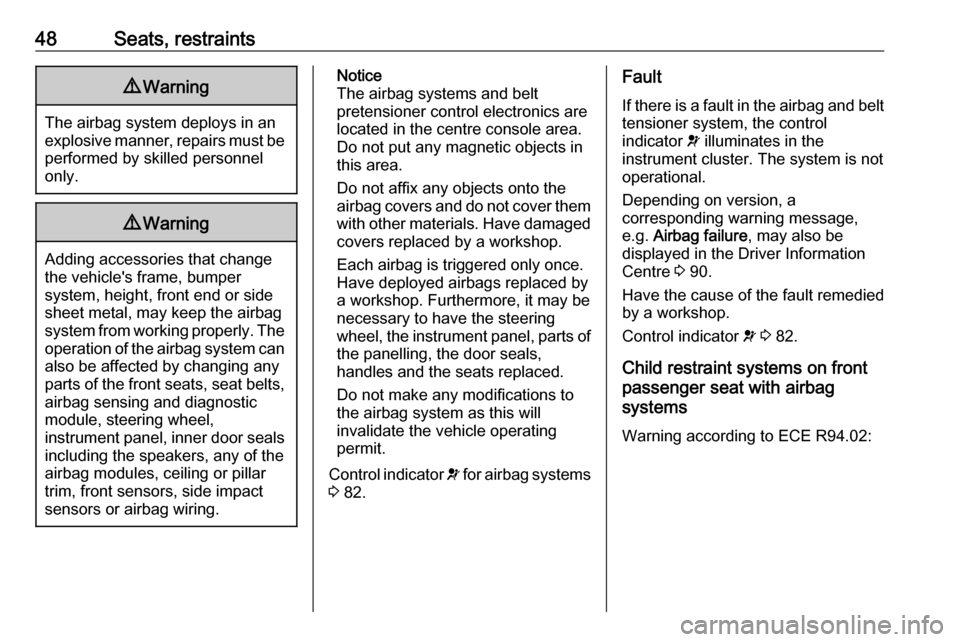
48Seats, restraints9Warning
The airbag system deploys in an
explosive manner, repairs must be performed by skilled personnel
only.
9 Warning
Adding accessories that change
the vehicle's frame, bumper
system, height, front end or side
sheet metal, may keep the airbag
system from working properly. The operation of the airbag system can
also be affected by changing any
parts of the front seats, seat belts, airbag sensing and diagnostic
module, steering wheel,
instrument panel, inner door seals including the speakers, any of the
airbag modules, ceiling or pillar
trim, front sensors, side impact
sensors or airbag wiring.
Notice
The airbag systems and belt
pretensioner control electronics are
located in the centre console area.
Do not put any magnetic objects in
this area.
Do not affix any objects onto the
airbag covers and do not cover them with other materials. Have damagedcovers replaced by a workshop.
Each airbag is triggered only once.
Have deployed airbags replaced by
a workshop. Furthermore, it may be
necessary to have the steering
wheel, the instrument panel, parts of
the panelling, the door seals,
handles and the seats replaced.
Do not make any modifications to
the airbag system as this will
invalidate the vehicle operating
permit.
Control indicator v for airbag systems
3 82.Fault
If there is a fault in the airbag and belt tensioner system, the control
indicator v illuminates in the
instrument cluster. The system is not
operational.
Depending on version, a
corresponding warning message, e.g. Airbag failure , may also be
displayed in the Driver Information Centre 3 90.
Have the cause of the fault remedied by a workshop.
Control indicator v 3 82.
Child restraint systems on front passenger seat with airbag
systems
Warning according to ECE R94.02:
Page 54 of 203
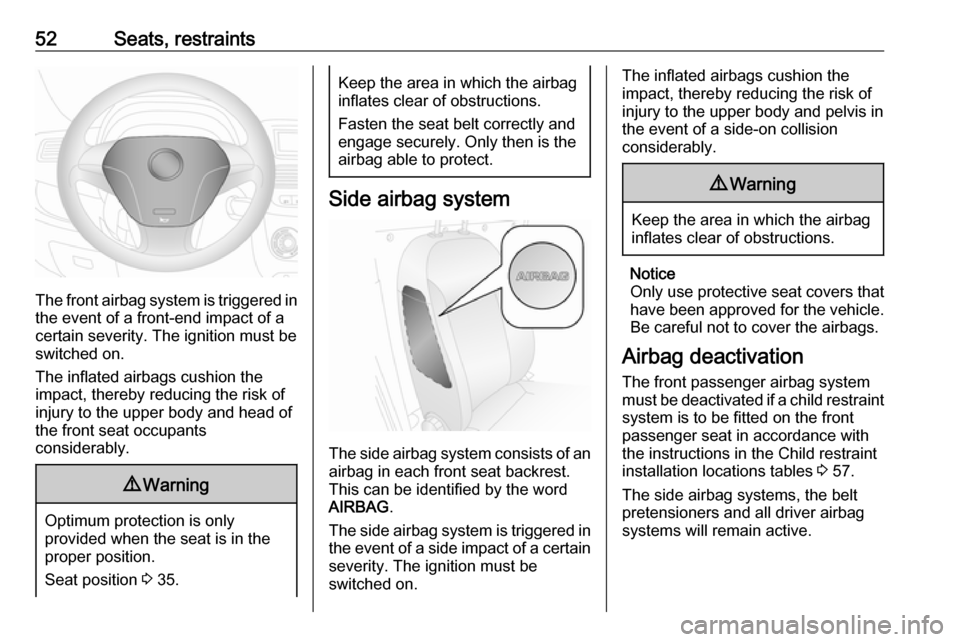
52Seats, restraints
The front airbag system is triggered in
the event of a front-end impact of a
certain severity. The ignition must be
switched on.
The inflated airbags cushion the
impact, thereby reducing the risk of
injury to the upper body and head of
the front seat occupants
considerably.
9 Warning
Optimum protection is only
provided when the seat is in the
proper position.
Seat position 3 35.
Keep the area in which the airbag
inflates clear of obstructions.
Fasten the seat belt correctly and
engage securely. Only then is the
airbag able to protect.
Side airbag system
The side airbag system consists of an
airbag in each front seat backrest.
This can be identified by the word
AIRBAG .
The side airbag system is triggered in the event of a side impact of a certain
severity. The ignition must be
switched on.
The inflated airbags cushion the
impact, thereby reducing the risk of
injury to the upper body and pelvis in
the event of a side-on collision
considerably.9 Warning
Keep the area in which the airbag
inflates clear of obstructions.
Notice
Only use protective seat covers that have been approved for the vehicle.Be careful not to cover the airbags.
Airbag deactivation
The front passenger airbag system
must be deactivated if a child restraint
system is to be fitted on the front
passenger seat in accordance with
the instructions in the Child restraint
installation locations tables 3 57.
The side airbag systems, the belt
pretensioners and all driver airbag
systems will remain active.
Page 56 of 203
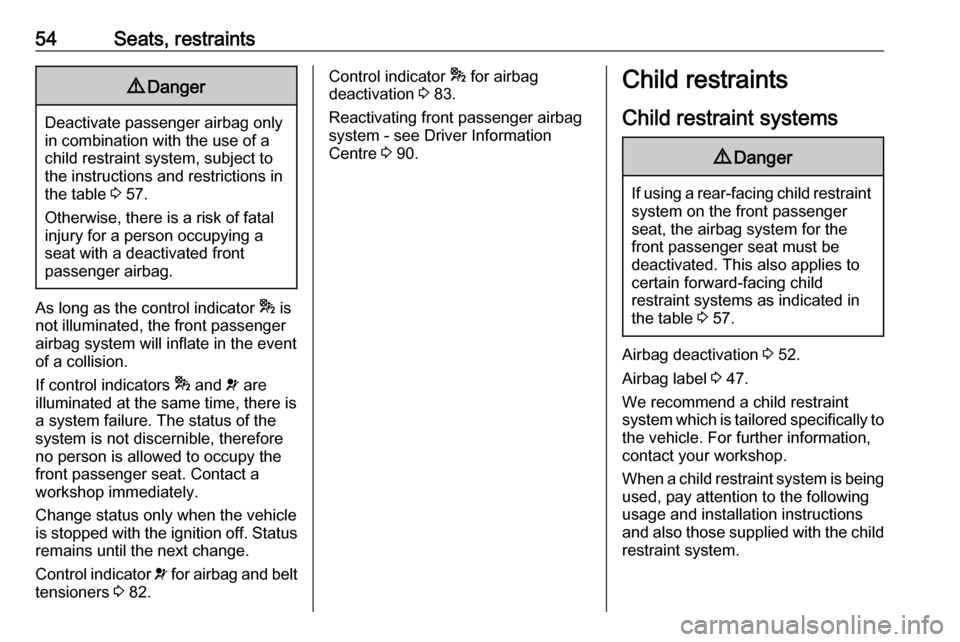
54Seats, restraints9Danger
Deactivate passenger airbag only
in combination with the use of a
child restraint system, subject to
the instructions and restrictions in
the table 3 57.
Otherwise, there is a risk of fatal
injury for a person occupying a
seat with a deactivated front
passenger airbag.
As long as the control indicator * is
not illuminated, the front passenger
airbag system will inflate in the event
of a collision.
If control indicators * and v are
illuminated at the same time, there is
a system failure. The status of the
system is not discernible, therefore
no person is allowed to occupy the
front passenger seat. Contact a
workshop immediately.
Change status only when the vehicle
is stopped with the ignition off. Status remains until the next change.
Control indicator v for airbag and belt
tensioners 3 82.
Control indicator
* for airbag
deactivation 3 83.
Reactivating front passenger airbag system - see Driver Information
Centre 3 90.Child restraints
Child restraint systems9 Danger
If using a rear-facing child restraint
system on the front passenger
seat, the airbag system for the
front passenger seat must be
deactivated. This also applies to certain forward-facing child
restraint systems as indicated in
the table 3 57.
Airbag deactivation 3 52.
Airbag label 3 47.
We recommend a child restraint system which is tailored specifically to the vehicle. For further information,
contact your workshop.
When a child restraint system is being
used, pay attention to the following
usage and installation instructions
and also those supplied with the child
restraint system.
Page 57 of 203

Seats, restraints55Always comply with local or national
regulations. In some countries, the
use of child restraint systems is
forbidden on certain seats.
Child restraint systems can be
fastened with:
● Three-point seat belt
● ISOFIX brackets
● Top-tether
Three-point seat belt
Child restraint systems can be
fastened by using a three-point seat
belt 3 45.
Depending on the size of the used
child restraint systems and the model
variant, child restraint systems can be
attached to certain 2nd row seats
3 57.
ISOFIX brackets ISOFIX mounting brackets are
indicated by ISOFIX labels on the
backrest.
Fasten vehicle-approved ISOFIX
child restraint systems to the ISOFIX
mounting brackets.
When using ISOFIX mounting
brackets for seat mounting,
universally approved child restraint
systems for ISOFIX may be used.
A Top-Tether strap must be used in
addition to the ISOFIX mounting
brackets.
Permissible mounting location
positions for ISOFIX child restraint
systems are marked in the tables by
< , IL and IUF.
Top-tether anchors
Top-tether anchors are located on the
back of the seat.
In addition to the ISOFIX mounting
brackets, fasten the Top-tether strap
to the Top-tether anchors.
ISOFIX child restraint systems of
universal category positions are
marked in the table by IUF 3 57.
Selecting the right system The rear seats are the most
convenient location to fasten a child
restraint system.
Page 58 of 203

56Seats, restraintsChildren should travel facing
rearwards in the vehicle as long as
possible. This makes sure that the
child's backbone, which is still very
weak, is under less strain in the event of an accident.
Suitable are restraint systems that
comply with valid UN ECE
regulations. Check local laws and
regulations for mandatory use of child restraint systems.
Ensure that the child restraint system
to be installed is compatible with the
vehicle type.
Ensure that the mounting location of
the child restraint system within the
vehicle is correct, see following
tables.
Allow children to enter and exit the vehicle only on the side facing away
from the traffic.
When the child restraint system is not in use, secure the seat with a seat beltor remove it from the vehicle.
Notice
Do not affix anything on the child
restraint systems and do not cover
them with any other materials.A child restraint system which has
been subjected to stress in an
accident must be replaced.
Child locks 3 24.
Page 59 of 203

Seats, restraints57Child restraint installation locations
Permissible options for fitting a child restraint system
Weight and age class
Front passenger seatSecond rowThird rowactivated airbagdeactivated airbagoutboard seatcentre seatGroup 0: up to 10 kg
or approx. 10 monthsXU 1U,
or approx. six to 12 yearsXXUUX1:When securing with a three-point seat belt, move seat to uppermost position and ensure that the seat belt runs
forwards from the upper anchorage point. Adjust seat backrest as far as necessary to a vertical position to ensure
that the belt is tight on the buckle side.<:Vehicle seat available with ISOFIX attachments. When attaching using ISOFIX, only the ISOFIX child restraint
systems permitted for the vehicle may be used.U:Universal suitability in conjunction with three-point seat belt.X:No child restraint system permitted in this weight class.
Page 71 of 203

Instruments and controls69Instruments and
controlsControls ....................................... 70
Steering wheel adjustment ........70
Steering wheel controls .............70
Horn ........................................... 70
Windscreen wiper/washer .........71
Rear window wiper/washer .......71
Headlamp washer .....................72
Outside temperature ..................72
Clock ......................................... 72
Power outlets ............................. 74
Cigarette lighter ......................... 75
Ashtrays .................................... 75
Warning lights, gauges and indi‐ cators ........................................... 76
Instrument cluster ......................76
Speedometer ............................. 76
Odometer .................................. 76
Trip odometer ............................ 76
Tachometer ............................... 76
Fuel gauge ................................ 77
Fuel selector .............................. 77
Engine coolant temperature gauge ....................................... 78
Service display .......................... 78Transmission display .................79
Control indicators ......................79
Generic warning ........................81
Turn signal ................................. 82
Seat belt reminder .....................82
Airbag and belt tensioners .........82
Airbag deactivation ....................83
Charging system .......................83
Malfunction indicator light ..........83
Brake system ............................. 84
Brake pad wear ......................... 84
Antilock brake system (ABS) .....84
Transmission ............................. 84
Gear shifting .............................. 85
Hill start assist ........................... 85
Ultrasonic parking assist ...........85
Electronic Stability Control ........85
Engine coolant temperature ......86
Preheating ................................. 86
Diesel particle filter ....................86
Tyre pressure monitoring system ...................................... 87
Engine oil pressure ....................87
Change engine oil .....................88
Low engine oil level ...................88
Low fuel ..................................... 88
Drain fuel filter ........................... 89
Immobiliser ................................ 89
Stop-start system ......................89
Exterior light .............................. 89High beam................................. 89
Fog light ..................................... 90
Rear fog light ............................. 90
Cruise control ............................ 90
Door open .................................. 90
Information displays .....................90
Driver Information Centre ..........90
Vehicle messages ........................95
Warning chimes .........................95
Fuel system messages ..............96
Trip computer ............................... 96
Page 83 of 203
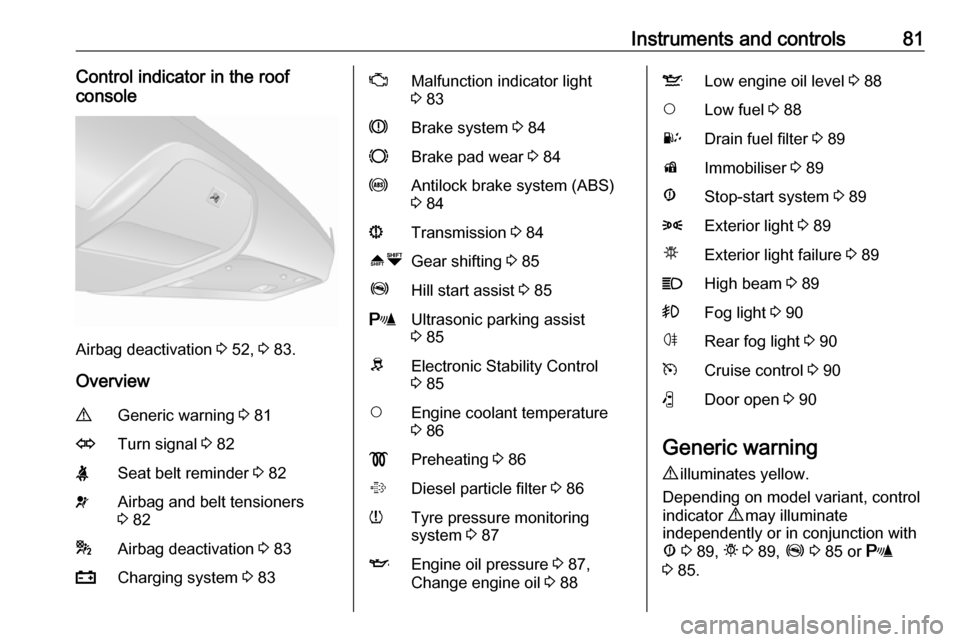
Instruments and controls81Control indicator in the roof
console
Airbag deactivation 3 52, 3 83.
Overview
9Generic warning 3 81OTurn signal 3 82XSeat belt reminder 3 82vAirbag and belt tensioners
3 82*Airbag deactivation 3 83pCharging system 3 83ZMalfunction indicator light
3 83RBrake system 3 84FBrake pad wear 3 84uAntilock brake system (ABS)
3 84sTransmission 3 84[ ÒGear shifting 3 85ZHill start assist 3 85rUltrasonic parking assist
3 85RElectronic Stability Control
3 85$Engine coolant temperature
3 86!Preheating 3 86%Diesel particle filter 3 86wTyre pressure monitoring
system 3 87IEngine oil pressure 3 87,
Change engine oil 3 88SLow engine oil level 3 88$Low fuel 3 88UDrain fuel filter 3 89dImmobiliser 3 89ÆStop-start system 3 898Exterior light 3 89µExterior light failure 3 89CHigh beam 3 89>Fog light 3 90øRear fog light 3 90mCruise control 3 90(Door open 3 90
Generic warning
9 illuminates yellow.
Depending on model variant, control
indicator 9 may illuminate
independently or in conjunction with
Æ 3 89, t 3 89, Z 3 85 or r
3 85.